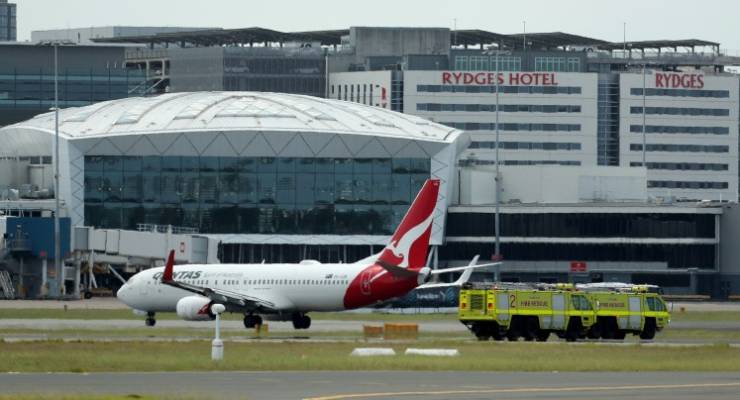
How much has Alan Joyce downed Qantas?
That’s the question on many minds after two emergencies in two days and three in the past month — something that has not happened in living memory.
On Wednesday Qantas’ lunchtime flight QF144 from Auckland to Sydney was forced to drop altitude and fly on one engine after the other one failed. It issued a mayday call that was later downgraded to a “PAN” (possible assistance needed). Yesterday its flight from Sydney to Fiji was forced to turn back. Described only as a “precaution”, in Qantas logs seen by Crikey the cause was the failure of the plane’s pitot probe — an instrument that measures fluid flow velocity.
And on December 23 its headline A380 en route from Singapore to London was forced into an emergency landing in the Azerbaijani capital Baku after a smoke alarm in the cargo hold was triggered prompting a mayday alert.
It’s now clear that CEO Joyce’s money-saving, share price-boosting program of delaying the replacement of Qantas’ ageing fleet and running down its engineering department is catching up with an airline that was once the gold standard, the envy of other airlines and something for Australians to be proud of. That is certainly not the case today.
What’s more, there is no relief in sight until Airbus begins deliveries in late 2024 at the earliest of Qantas’ order of A320 single-aisle planes which will replace the venerable fleet of 75 Boeing 737-838 aircrafts, the oldest of which is 21 and the youngest nine, with an average age of 14.5 years.
It’s the same story for its A330s; the oldest of these is also 21 and the youngest 10, average age 15.4. No aircraft have yet been ordered to replace these twin-aisle planes which fly Asian and Pacific routes. The pandemic has seen Airbus and Boeing forced to delay future deliveries, meaning that when Qantas finally places an order to replace them, the new aircraft will still be years away.
For its six operational double-decker, long-haul A380s, the fleet’s average age is 13. Four more are due from storage over the next 12 months or so. It’s an aircraft that has always been delicate and prone to physical issues because of its massive size. Most recently, Qantas was forced into a time-consuming process of checking for and repairing wing cracks on its fleet.
Only the 11 Boeing 787s — with an average of four years — are of an age that Qantas’ competitors Singapore Airlines, Emirates, Etihad and Qatar would run. There are three more 787s due back next year.
Still, Qantas has multiple problems with its 787s. In early January one was stuck in Dallas for almost a week with an oil leak, causing havoc on its North American routes, company sources said. A number of Australia-Los Angeles flights were also cancelled due to maintenance issues.
Before the engine failure Qantas already had 13 of its 737 engines “on watch” for overheating and excess oil consumption.
“All of the engines that we are doing additional monitoring on are operating within the manufacturer’s guidelines,” Qantas said in response to questions from Crikey. It is not known if the engine on QF144 was on watch before it failed. Pilots say they have been concerned at fluctuations of up to 80 degrees between 737 engines.
“Variation in engine temperatures across a fleet of 737-800 aircraft is normal,” Qantas said.
General Electric no longer makes the CFM56-7 engine that Qantas’ 737s use. This is not uncommon but it leaves Qantas having to refurbish its engines. Internal sources say about half a dozen of these are currently stuck in China, though the company said there are “sufficient CFM56-7 engines for the life of Qantas’ fleet of B737s”.
Crikey also understands that there have been multiple engine failures over the past two years on the Boeing 717 aircraft its regional networks use. Qantas would not answer questions about these.
The Air Transport Safety Board (ATSB) made a rare foray into the public arena yesterday when it announced an investigation into the QF144 engine failure. It said it would “quarantine” the flight recorder.
There is much to look at, not least the apparent discrepancy in three separate pieces of communication about precisely when the engine on QF114 failed. In a mayday situation, pilots must fly to the nearest available airport. The flight time of QF144 was three hours and 15 minutes. The flight plan issued by the company to the pilot stated one hour and 24 minutes as the time at which the aircraft would still proceed to Sydney if the engine failed; any earlier it would return to Auckland.
Exhibit A is the Qantas log by pilot Adam Susz, a copy of which has been obtained by Crikey. This states “engine 1 failure … approx one hour 25 minutes after take-off”.
Exhibit B was Qantas’ internal staff communication on its “just landed” portal that stated that an “engine shutdown” occurred “about an hour” before the aircraft was due to land in Sydney, so two hours and 15 minutes after take-off.
Exhibit C is the record of flight-tracking website Flight Aware. It says the aircraft took off at 12.30pm AEDT, climbing to 36,000 feet to level at about 12.45pm. It flew level until 1.20pm, 50 minutes after take-off. At the decision point of one hour and 24 minutes after take-off as per the flight plan, the aircraft was at 31,000 feet. Pilots say this signified that the plane had lost altitude because it had lost an engine and commenced what is known as “drift down”.
If the engine failed before one hour and 24 minutes out of Auckland, it should have returned. This would have been far more problematic for Qantas. The company has declined to comment on the discrepancies, which will form part of the ATSB inquiry.
The broader context of Qantas’ emerging technical problems is a stretched, under-resourced engineering workforce that has been shorn of much of its deep experience. During the pandemic, Joyce sacked thousands of staff and packed many off with redundancies, including many experienced licensed aircraft maintenance engineers.
Engineers who spoke to Crikey said maintenance on aircraft was being delayed beyond Qantas’ previous standards and a lack of experienced staff was also slowing down essential maintenance work.
Qantas management has woken up, at least in part, to its engineering problem. It has cut a new enterprise bargaining agreement with the engineers union which is far more generous than its company-wide offer. Engineers begin voting on a new EBA today, which closes January 25 — it is expected to pass easily.
Old hands say Qantas is an airline operating under stress, with insufficient operational staff who have insufficient experience. Management is not listening to pilots, flight crew and engineers at the coalface. The airline is being run for shareholders — and management bonuses — not for passengers and staff, and this is stretching the fleet.
Crikey understands the ATSB inquiry will cover the entire gamut of Qantas’ 737 operations from aircraft to engine, spare parts availability to manpower.
People inside Qantas, in this situation for at least six months, have been concerned that something was going to give in terms of safety. It seems to be giving now.
It’s well past time that management — and the board — took a good hard look at the airline as it teeters on the precipice of its reputation.








Ever since Qantas outsourced some its maintenance to Malaysia to cut costs it has had more “in air incidence” than any other major airline in the world every single year. I would suggest that this story today just reinforces that Qantas is probably the most unsafe airline in the world to fly on today. When boardroom bonuses Trump safety that is the time to stop flying on that airline. Sadly that has been the case for almost a decade or more for Qantas…
According to Travel & Leisure: ‘Qantas has been named the safest airline in the world for 2023, regaining the top spot after being downgraded to second-best last year’, I wonder if that’s PR 🙂
I would be curious to see the source of your claim. Is there a website with the incident data comparisons?
If Qantas is pushing its engines to the limit my worry would be that one day two of them will pack up on the one flight. This is Joyce gambling with people’s lives. Qantas should never have been sold off but given that happened it is up to the authorities to enforce proper standards.
You can not de-value maintenance and expect reliability. Joyce will turn this airline into a small business ripe for takeover if the current trends continue. Either that or worse case of going broke.
Another case of poor privatisation.
But chairman goyder tells us Joyce is the best ceo in australia
Qantas’ greatest asset is its safety record, which Joyce seems to be gambling with. That makes him Qantas’ greatest liability.
Ain’t neo-conservative economics wonderful…benefitting the already rich, manufacturers, shareholders and management. As always, the losers are the public, the workers, the loyal staff, those killed in accidents caused by cost cutting…..pretty much all those not in the “club”. When will an enlightened Gov’t call it for the fraud that it is? Some Scandinavian countries legislate CEO salaries and bonuses as multiples of the lowest salaries paid, banned salaries based on share-market performance, and more. The present system rewards wage-cutting, staff number cutting, maintenance and spares reduction, and the rest.
My hope for an enlightened Labor Gov’t is dead.
A major disaster is inevitable.